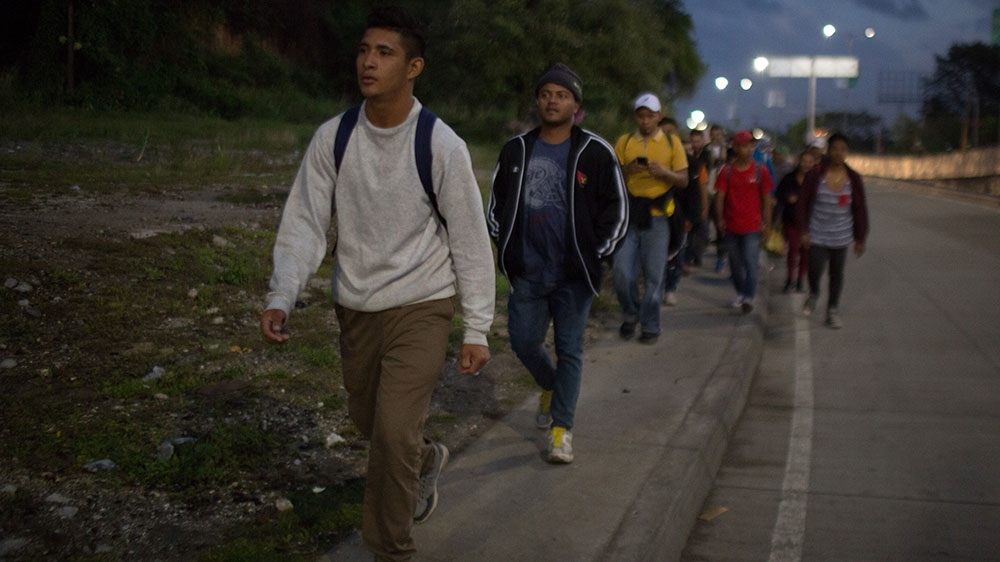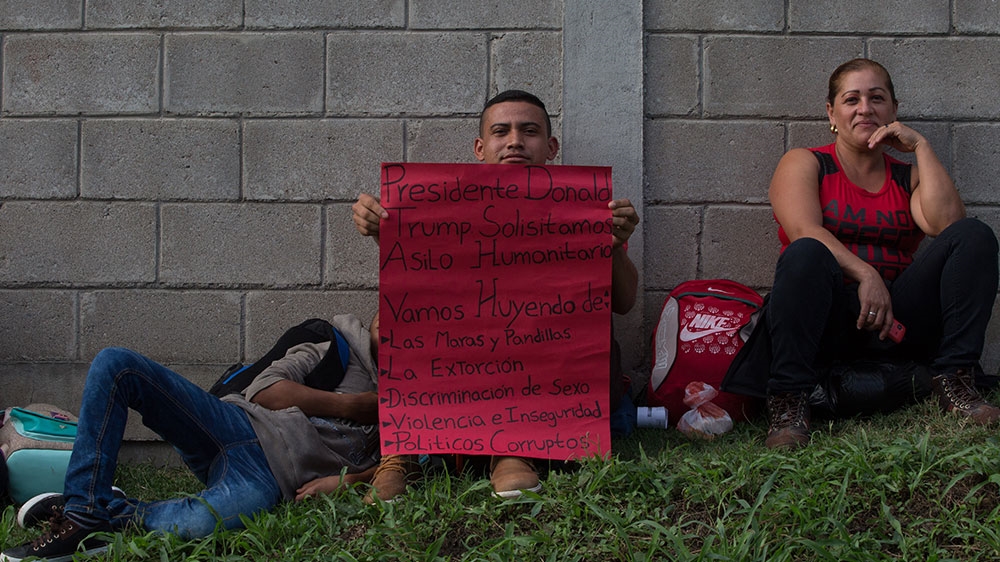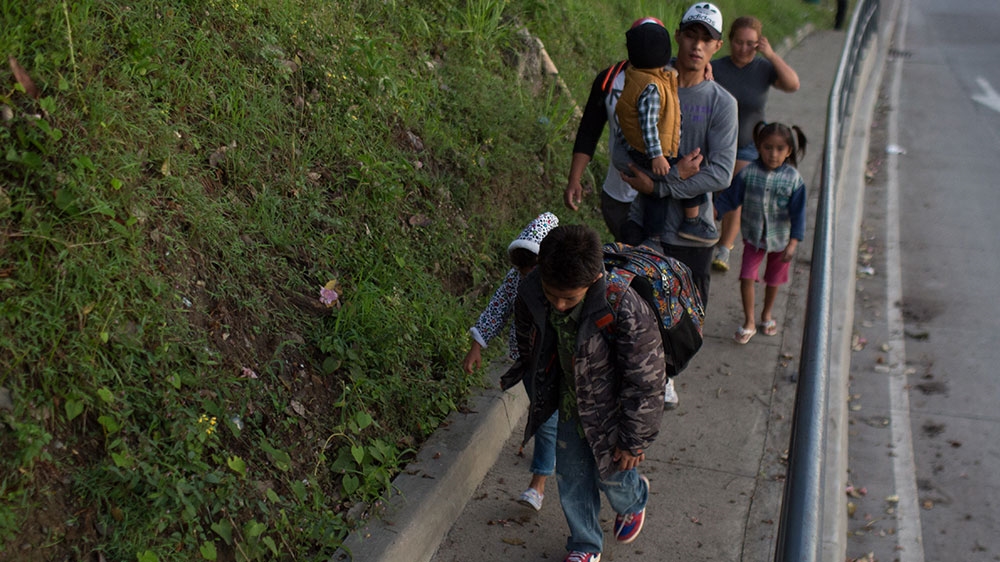
San Pedro Sula, Honduras – It was still dark when hundreds of Hondurans set out for the border with Guatemala as part of new caravan of US-bound migrants and asylum seekers.
“The economic crisis has been tremendous, with unemployment going up and corruption getting worse,” Daniel Munoz, a 38-year-old from Honduran department of Cortes, said as he joined his 16-year-old daughter and others on the second group of the caravan on Tuesday. Another group, which eventually grew to more than a 1,000 participants, left late on Monday.
“These are the reasons why we must migrate to another country,” Munoz told Al Jazeera.
The family, like so many that joined him on Tuesday morning, has seen their cost of living steadily increase in the last three years, but the amount that Munoz earned transporting sawdust was not enough to cover their bills.
“The cost of water and energy went up,” Munoz said. “There are times when we did not have enough to cover the costs.”
His daughter, Stephanie, hopes that she will be able to continue with her studies in the United States, and attend university where she wants to study journalism, and then get a job.
Youth like Stephanie face a difficult reality in Honduras where there are few opportunities for work.
“There are so many youth looking for work, but they are unable to find work,” she said.
“People look, but they don’t have the education that is required,” she said. “It makes me sad that they are unable to find work.”
Others caravan participants are fleeing violence or political persecution.
 |
| Migrants and asylum seekers part of a new caravan leaving Honduras set off from San Pedro Sula [Jeff Abbott/Al Jazeera] |
Marta Grady, who departed on Monday, said she cannot “endure this crisis (in Honduras) any more”.
“There is no work here. How are we going to eat. Since (Honduran President) Juan Orlando (Hernandez) entered office, things have gotten worse. There are no solutions,” she told Al Jazeera.
The 35-year-old has owned different businesses, including selling fruit and selling fresh meat, but failed to earn enough to support her family. She began planning on leaving with the caravan in December when she first learned about the caravan.
“We were not prepared when the first caravan left,” she said, referring to the thousands of Central Americans who left the region in October of last year. “Now we are ready to go. We are leaving everything.”
The group will make their way to the US border over the next several weeks. They will eventually join the thousands from October’s exodus still at the border awaiting processing by US immigration authorities, who have implemented a “metering system”, limiting the number of asylum applications that are processed each day. Others from last year’s group have either crossed the border between official ports of entry, found work in Mexico or returned home.
 |
| Carlos Maldonado holds a sign addressed to Trump outside the San Pedro Sula bus station [Jeff Abbott/Al Jazeera] |
US President Donald Trump has attempted use the caravans as a way to sow fear among Americans and make his case for a wall on the US-Mexico border. Key parts on the US government shut down on December 22 after Trump refused to back down on his demand for $5.7bn in wall funding on the US southern border, saying there is a “humanitarian crisis” at the border. Critics, including Democrats, argue the wall is immoral and a vast overreaction.
Carlos Maldonado, a 26-year-old from Paradiso, sat next to Grady holding a sign addressed to US President Donald Trump.
“Trump, we request humanitarian asylum,” the sign read. “We are fleeing gangs, extortion, sexual discrimination, violence and insecurity and corrupt politicians.”
Maldonado said this is the only opportunity he has.
“I need to take advantage of it,” he told Al Jazeera.
Exodus from Central America
Caravans from Central America are not rare. Those fleeing hope to find safety in numbers as they travel more than 2,000km north. According an Associated Press tally, nearly 4,000 migrants and refugees have died or gone missing along the route since 2014.
The Trump administration deployed thousands of active duty US troops to the border, falsely labelling the collective exodus an “invasion”.
After a number of large caravans left Honduras in October, the Trump administration pressured the governments of Central America to stop the caravans from advancing. As a result, the governments of Honduras and Guatemala deployed military and police to the border crossing to turn back potential migrants and refugees headed towards the US.
 |
| A family migrating with the Honduran caravan tails behind the rest of the group as it leaves San Pedro Sula [Jeff Abbott/Al Jazeera] |
In December, police and members of the US-equipped Honduran inter-agency task force, Maya Chorti patrolled the popular routes for migrants. The officers and soldiers stopped vehicles and asked travellers for identification and whether they had a visa to travel in Mexico. Those who did not were turned back.
The Honduran Government announced on Monday that it would uphold laws that cover child trafficking in the region. The Honduran Directorate of childhood, adolescence, and family issued a statement that reiterating that those that try to take children out of the country without the proper documentation could face up to three years of imprisonment. Some 60 children were stopped by Honduran authorities on Monday and Tuesday for not having proper documentation, according to officials.
Citizens of Guatemala, Honduras, El Salvador, and Nicaragua are free to travel without a passport between the four countries due to an agreement signed between the governments in 2006.












